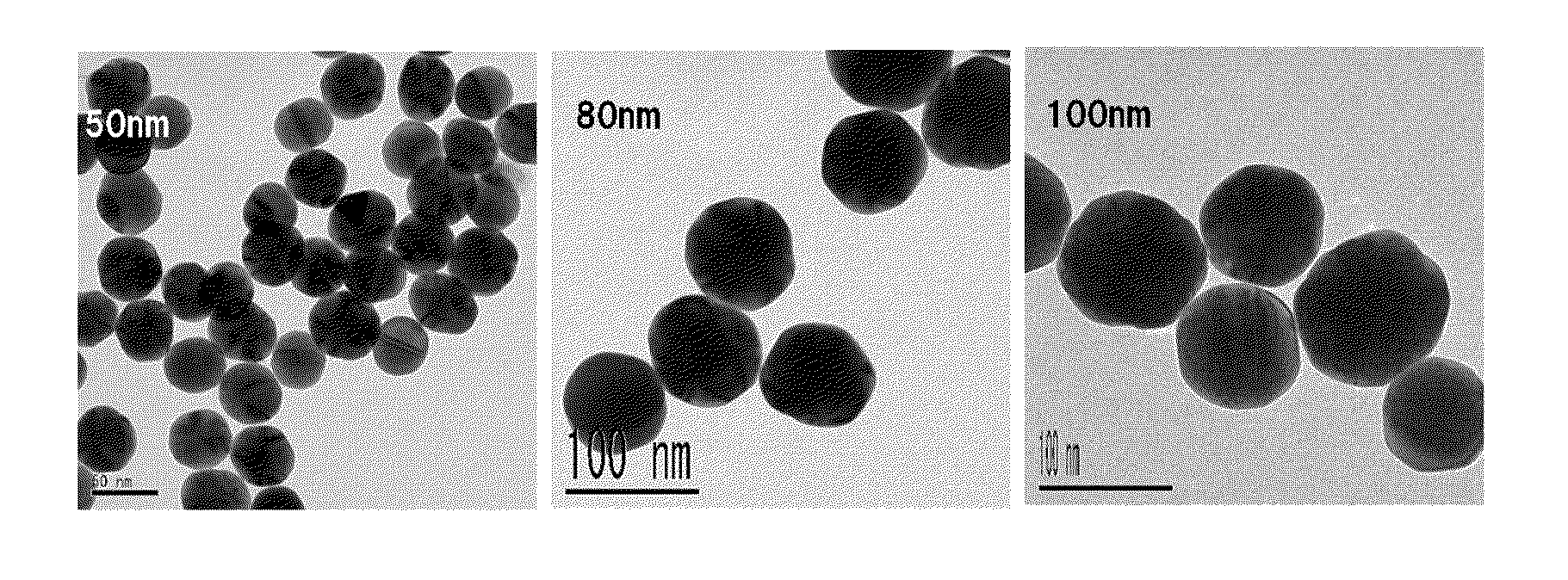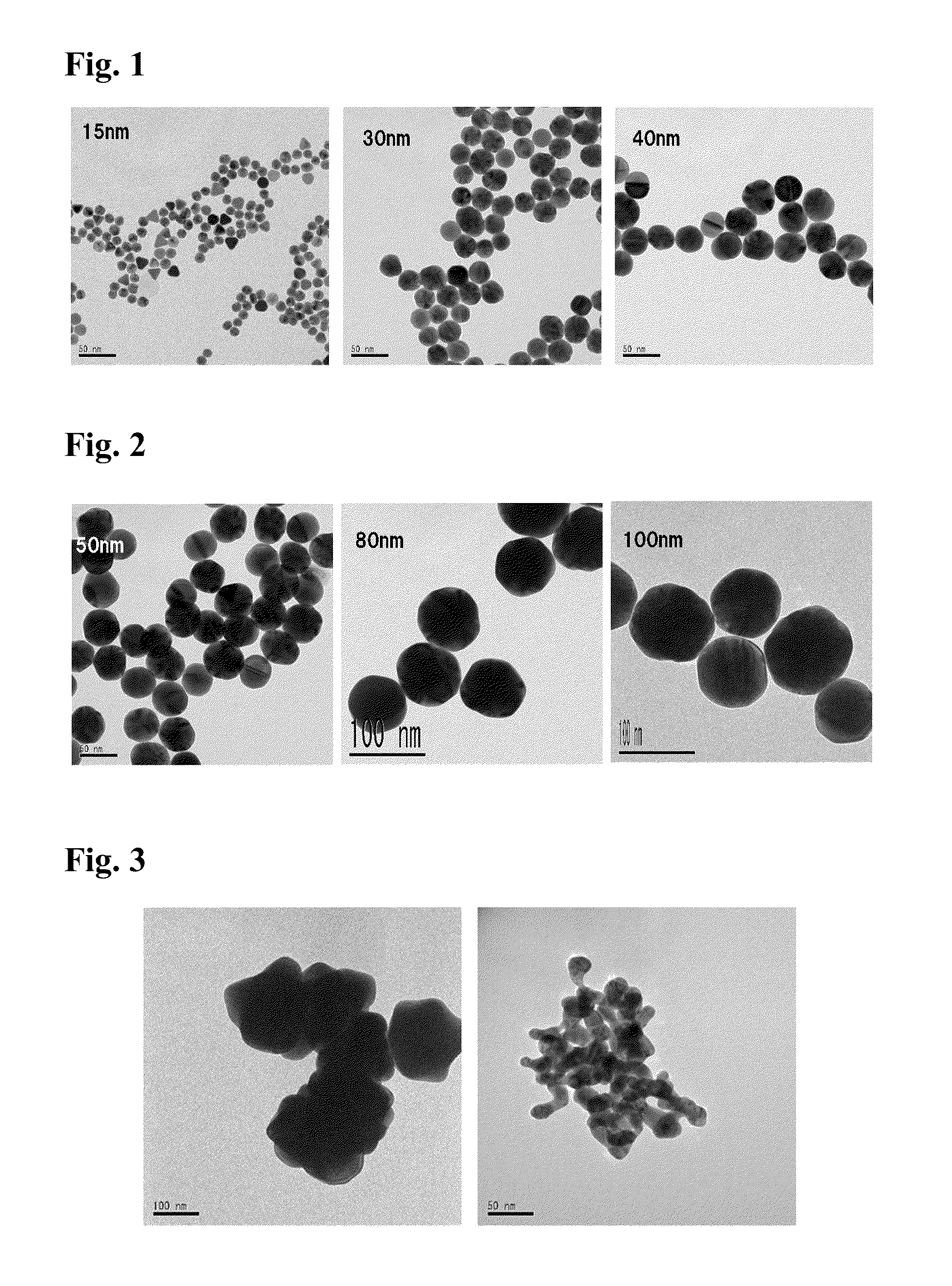Process for production of colloidal gold and colloidal gold
a colloidal gold and colloidal gold technology, applied in the field of colloidal gold production, can solve the problems of inability to obtain spherical shape, and inability to obtain gold colloid with sharp particle size distribution,
- Summary
- Abstract
- Description
- Claims
- Application Information
AI Technical Summary
Benefits of technology
Problems solved by technology
Method used
Image
Examples
example 1
[0061]In this example, gold chloride as the first gold salt was reduced by a citrate serving as the first reducing agent in the nucleation step to obtain nuclear colloid having a targeted size of 15 nm. Thereafter, in the growth step, gold chloride as the second gold salt and L-ascorbic acid as the second reducing agent were simultaneously added dropwise to form gold colloid having a targeted size of 30 nm.
[0062][Nucleation Step]
[0063]Gold chloride tetrahydrate (0.17 g, 4.1×10−4 mol) and trisodium citrate dihydrate (0.49 g, 1.6×10−3 mol) were dissolved respectively in 25 ml and 100 ml of ultrapure water, to prepare a gold chloride solution and a citric acid solution. Subsequently, a 500-ml three-neck flask was charged with the 6 ml of gold chloride solution and 200 ml of ultrapure water and refluxed with heating for 30 minutes. After the temperature of the solution became stable, 50 ml of citric acid solution was added and refluxed with heating for 15 minutes. Thereafter, heating wa...
example 2
[0066]In this example, gold colloid having a targeted particle size of 40 nm was produced. Nuclear colloid (26 ml, average particle size: 15.22 nm, 3.0×10−4 mol / L) formed in the nucleation step of Example 1 was used as nuclear colloid, and a 252 ml of gold chloride solution having gold chloride tetrahydrate (0.076 g, 1.8×10−4 mol) dissolved therein and 256 ml of L-ascorbic acid solution having sodium L-ascorbate (0.092 g, 4.6×10−4 mol) dissolved therein were used. The conditions other than the above were the same as those in the method employed in the growth step of Example 1. Note that the addition amounts of gold chloride and sodium L-ascorbate were calculated by setting constant α at 1.4 and constant β at 3.5.
example 3
[0067]In this example, gold colloid having a targeted particle size of 50 nm was produced. Gold colloid (12 ml, average particle size: 15.22 nm, 3.0×10−4 mol / L) obtained in Example 1 was used, and a 233 ml of gold chloride solution having gold chloride tetrahydrate (0.072 g, 1.7×10−4 mol) dissolved therein and a 233 ml of L-ascorbic acid solution having sodium L-ascorbate (0.094 g, 4.7×10−4 mol) dissolved therein were used. The conditions other than the above were the same as those in the method employed in the growth step of Example 1. The gold colloid of Example 2 used herein was obtained by growing nuclear colloid in a single growth step. Therefore, in Example 3, the growth step came to be performed twice in total. Note that the constants α and β used in calculating the addition amounts of gold chloride and sodium L-ascorbate were set at 1.4 and 3.8, respectively.
PUM
| Property | Measurement | Unit |
|---|---|---|
| Fraction | aaaaa | aaaaa |
| Volume | aaaaa | aaaaa |
| Particle size | aaaaa | aaaaa |
Abstract
Description
Claims
Application Information
 Login to View More
Login to View More - R&D
- Intellectual Property
- Life Sciences
- Materials
- Tech Scout
- Unparalleled Data Quality
- Higher Quality Content
- 60% Fewer Hallucinations
Browse by: Latest US Patents, China's latest patents, Technical Efficacy Thesaurus, Application Domain, Technology Topic, Popular Technical Reports.
© 2025 PatSnap. All rights reserved.Legal|Privacy policy|Modern Slavery Act Transparency Statement|Sitemap|About US| Contact US: help@patsnap.com



